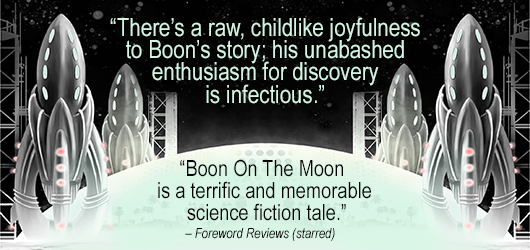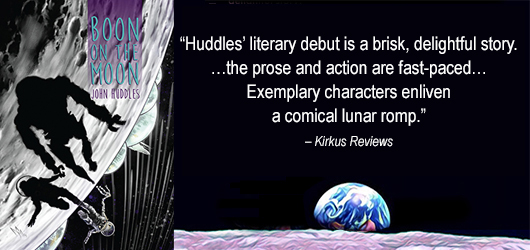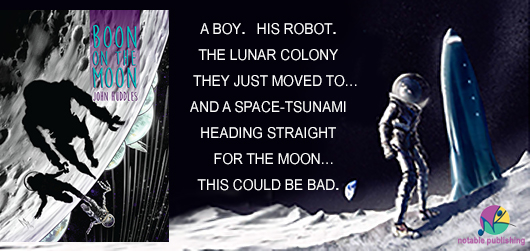It looks like you've stumbled upon a page meant to be read by our code instead of viewed directly. You're probably looking for this page.
Reviewer Peter Dabbene Interviews John Huddles, Author of Boon on the Moon
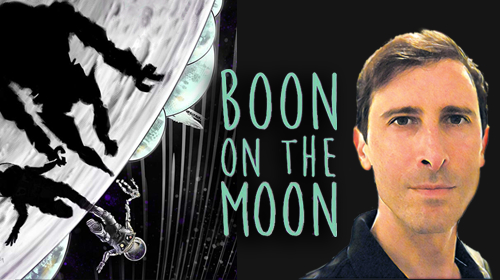
At Foreword, we’re always on the lookout for great juvenile fiction because nothing in our industry 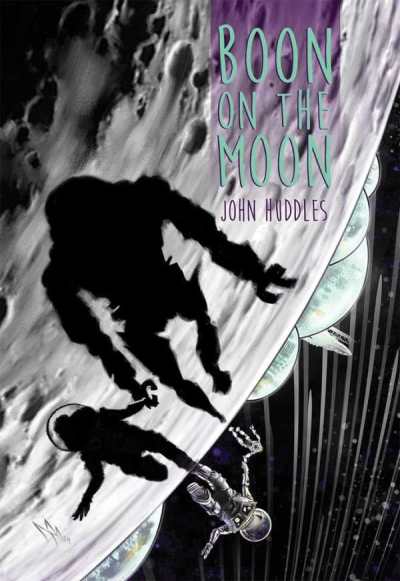
is more satisfying than the thought of countless girls and boys setting aside their phones for a few hours to flip pages in a book. That’s as good as it gets.
So when reviewer Peter Dabbene recently summed up his starred magazine review of Boon on the Moon by exclaiming that there’s a “raw, childlike joyfulness to Boon’s story; his unabashed enthusiasm for discovery is infectious. … Boon on the Moon is a terrific and memorable science fiction tale,” we danced a little jig.
With the help of Notable Kids Publishing, we lined up the following conversation between Peter and Boon author, John Huddles, to discover some of the secrets of hooking kids on a story.
Peter, take it from here.
John, you’ve done screenwriting and direction for films, was Boon on the Moon a project you had in your back pocket for a long time, or is it a more recent development? What inspired the idea?
Story ideas tend to roll around in my head for a while before I finally get around to writing them up. This is how it happened with Boon. But I find that thinking for a long time about a story before committing it to the page, even if we’re talking about a few years, gives rise to a pleasurable level of detail.
The inspiration for Boon was really just a simple desire to spend time on a story that would be pure fun to write and, with any luck, some amount of fun to read. I wanted to explore a fictional world where every element was joyful: personalities, rivalries, locations. A world where even the danger entertained. And a story in that world with a level of detail aspiring to be immersive—for instance, the air in the lunar colony that smells like hot-buttered popcorn—to make it all the more fun to imagine living in. So Boon staked its claim on me as much as the other way around.
“Cinematic” is an overused adjective, but many elements of Boon on the Moon seem to fit that description. Can you talk about the pros and cons of writing a novel, versus those of screenwriting? How have your film experiences affected your writing style?
Writing a screenplay is undemanding compared to writing a novel. A screenplay is only a blueprint, but since a novel is a whole, finished work, you need to own every sentence, every word, every comma. It’s all on you—and there’s no hiding. Scriptwriting does help though when it comes to fiction, because scriptwriting forces you to boil down your story to its core assets: plot and characterization. I find this to be a transferable skill set in writing fiction. And once you know the core, you know where you have room to roam around it.
One of the things I love about the book is that it reflects values of our modern society—multiculturalism features prominently, for instance—yet it still captures the joy of science, and science fiction, in a way that’s reminiscent of Robert Heinlein’s juvenile sci-fi novels from the 1950s. It also reminded me a bit of Bill Watterson’s Calvin and Hobbes, with Boon’s imaginary seven-foot robot Jose Ignacio constantly advising Boon to rethink some of his outlandish schemes. Are there any authors or books that you would cite as influences?
Well, you’ve named two things that I love. I remember being age twelve and discovering the shelf of Heinlein’s juvenile sci-fi novels in the school library, which I went through one after the other until there wasn’t a sentence left. And Calvin and Hobbes, of course, is a masterpiece. I wasn’t intentionally trying to pay homage to these amazing works in Boon, but if there’s even the slightest resemblance, I’ll take it.
My favorite sci-fi book of all time is Frank Herbert’s monumental Dune, and I seem to recall that in the preface, Herbert says something to the effect of: his overall goal was to provide entertainment for the person who’d paid good money to buy a copy, even though (my words now) it’s a magnum opus of philosophy, futurism, religion, and ecology. I can’t cite Dune as an inspiration for Boon (rhyming, monosyllabic titles notwithstanding), but I do like the idea of not forgetting to entertain first and foremost. I’m very mindful that kids either like what they read or they don’t. You can’t fool them with literary tricks or concepts.
Boon on the Moon strikes a wonderful balance between fantasy-adventure and real science; in the book, a crisis is caused by the appearance of a “white worm,” which you describe as a supernova that has imploded. Is this a real phenomenon (whether observed or theoretical), or is something you created from scratch for the story?
The white worm in Boon is one part science fact, one part science fiction, and several parts poetic license. An imploding supernova is how an actual black hole is formed—if I haven’t gotten the physics of that wrong—and there’s been much theorizing in science about the connection between a black hole and a worm hole. But for the purposes of plot, the white worm in Boon needed to be its own invented thing and go its own concocted way. I hope that if any kid reading the book is interested enough, she or he will look up the real science behind cosmic phenomena and, by way of Boon, draw distinctions between the fictional and the actual.
Boon is a quintessential ten year old boy, curious and always looking for excitement. Any resemblance between Boon and a ten-year-old John Huddles?
I would love to say yes, because I find Boon to be a riot and it would be nice to think of myself that way at his age. Alas, not even close. At age ten, my time was pretty much evenly divided between books and tennis. No danger, space-related or otherwise, was in the picture. And any excitement was all in my head.
Boon on the Moon is also referred to as “The Booniverse: Book One.” This, combined with a great ending that hints at more to come, seems to indicate a sequel, or sequels, may be in the works?
If I had the time, and if enough readers cared, I could write a dozen books set in The Booniverse. There’s no shortage of stories to tell about Boon’s life. And the people in his life, notably his classmate, Honeybun Bajpai, also bring a lot to the table.
That said, the immediate sequel to Boon On The Moon is definitely in the works. If it’s of interest, I’ll share the title here: Too Much Moon: Book 2 From The Booniverse.
It’s about timeline disruptions, space-allergies, and a threat to snacking worldwide. But I’ve already said too much!
Boon on the Moon
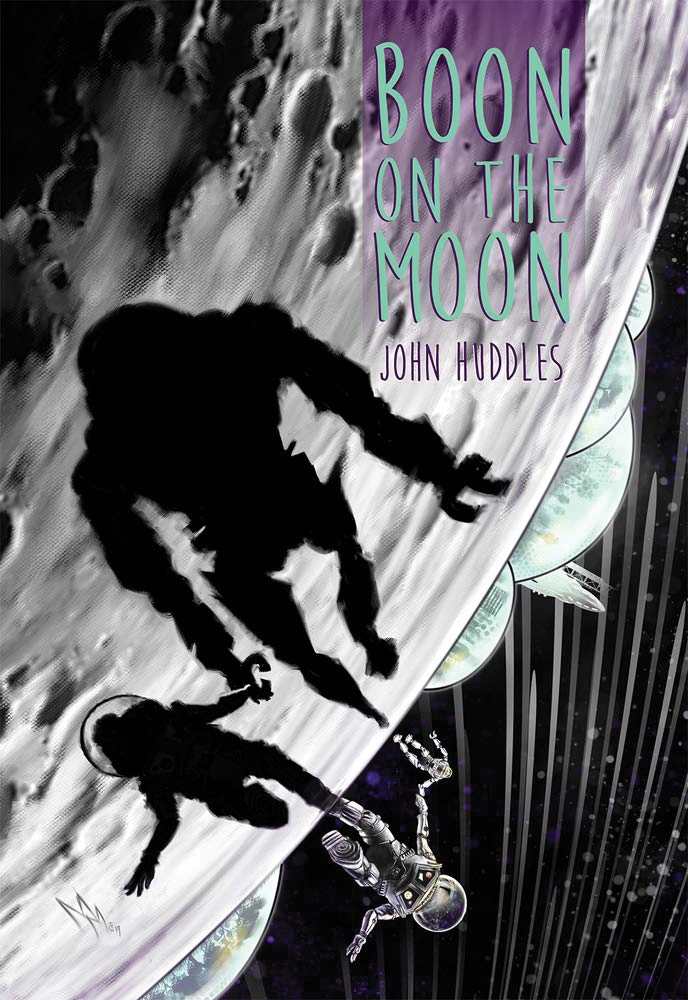
John Huddles
Notable Kids Publishing
Hardcover $16.95 (216pp)
978-0-9970851-8-1
Buy: Local Bookstore (Bookshop), Amazon
A boy and his robot move to Earth’s moon in John Huddles’s wonderful Boon on the Moon.
Byron “Boon” Barnett’s dream comes true when his father gets a job opportunity on the Moon; with some lobbying from Boon, the whole family is soon on their way. Boon gets right to exploring the Moon with his robot, Jose Ignacio, and is soon confronted with several hazardous situations, foremost the arrival of a “White Worm”—a part black hole, part wormhole destructive force of nature. A series of exciting rescues by Boon, and ingenious scientific thinking by his family, avert the crisis, saving humanity from a terrible fate.
Boon’s relationship with Jose Ignacio is special: to everyone else, Jose Ignacio is just a twelve-inch-tall toy robot, but to Boon he’s a seven-foot-tall giant. In Boon’s mind, they banter and bicker like a comedy team, and the reproachful robot serves as foil and sounding board for Boon’s schemes. The ultimate fate of Boon’s imaginary friend is a poignant instance of growing up.
Italics emphasize bits of dialogue throughout, an enjoyable oral element through which the book begs to be read out loud. This technique makes conversations more emotional, humorous, and realistic, as when Mrs. Barnett discusses Boon, saying, “Get rid of his fears? I’ve been working his whole life to get some fears into him!” Novel features—like the moon’s Worship Dome, which is equipped with a hologram generator so its interior can look like any house of worship; and space art, which uses a laser to create images on celestial objects—amplify the immersiveness of Boon’s future world, one that’s full of advanced technology.
There’s a raw, childlike joyfulness to Boon’s story; his unabashed enthusiasm for discovery is infectious. Combining innocent wonder with hard science, Boon on the Moon is a terrific and memorable science fiction tale.
PETER DABBENE (February 27, 2020)
Peter Dabbene
